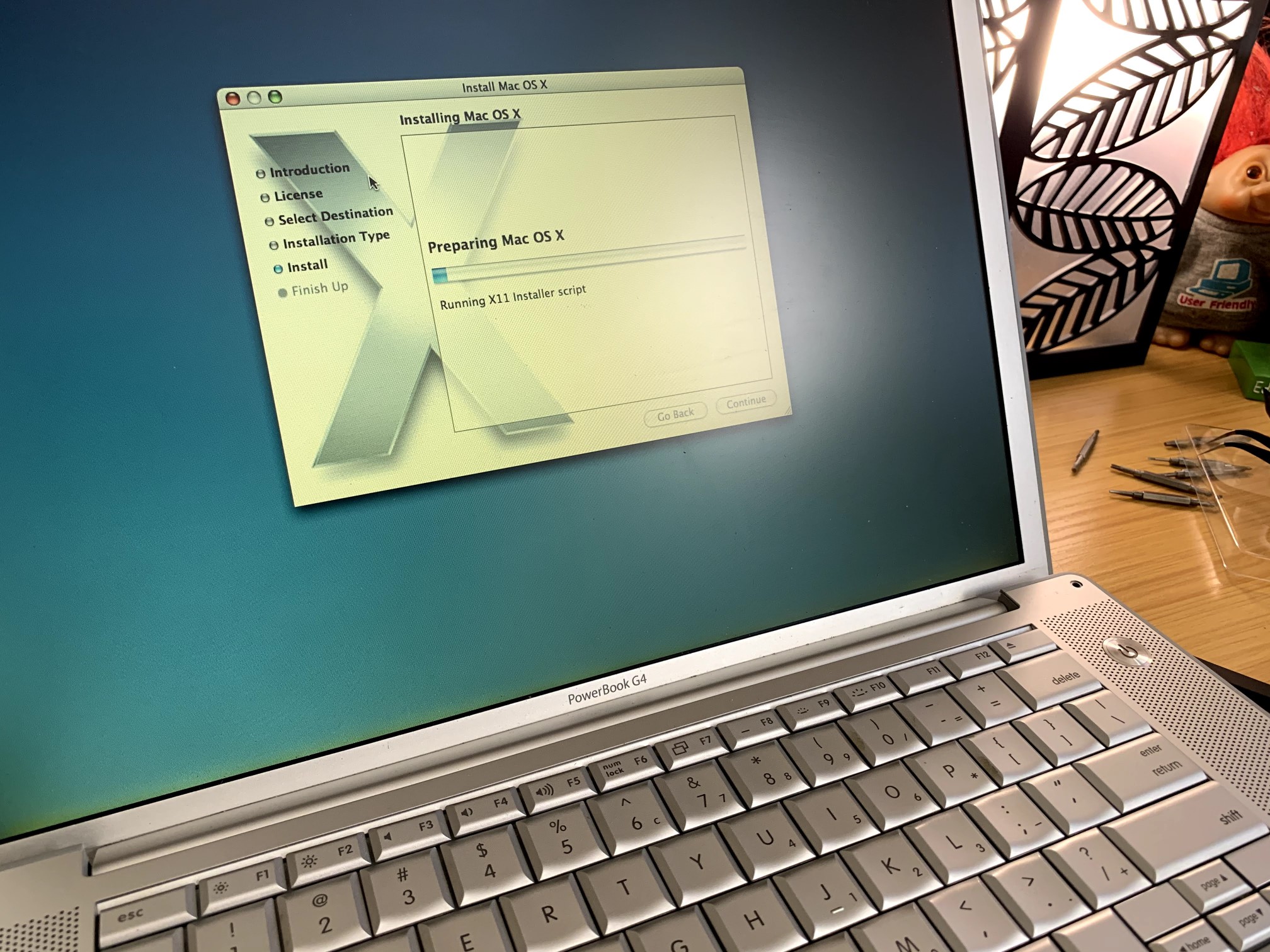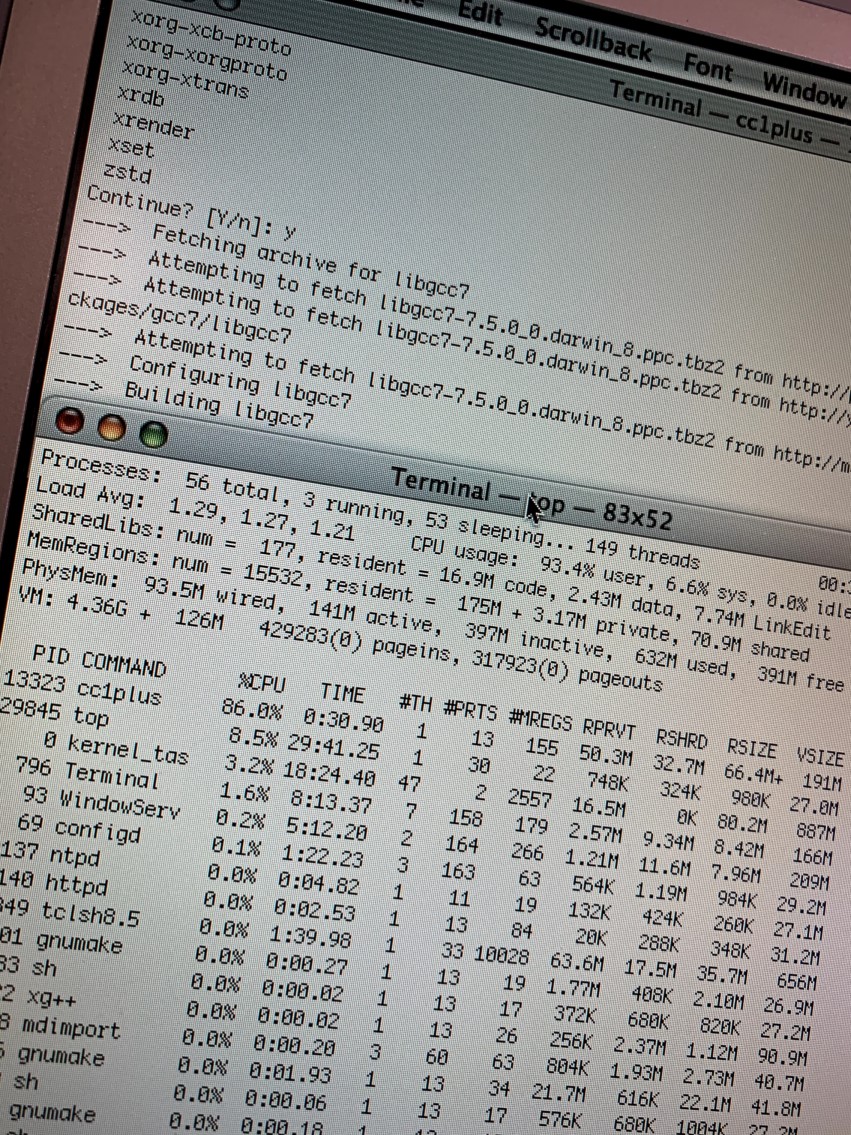Refurbing a PowerBook G4
So, I have this PowerBook G4 that’s been sitting on a shelf for a while. It’s not a terribly interesting model - just a regular 15” one, second-to-last generation, that’s basically stock except for a slightly upgraded hard drive (faster, but not any more spacious). I believe I originally got the machine maybe 12-13 years ago as a “it’s gonna get thrown out otherwise” deal from one of the various jobs I’ve had, just as an extra machine to do things with. (It’s old enough that Intel machines were out by this point, and this was even then skirting the edge of usefulness as a PowerPC Mac.) At some point, it got given to a friend to use for audio stuff, and then ended up back in my hands a year or two ago, where it’s sat since then. I think I tried to power it up once and it really wasn’t having it, so it got turned back off and shelved.
I ran across the thing the other day while doing some reorganizing and decided, why not see if this thing works? So, I pulled a power adapter (fortunately I actually have a couple!) and gave it a shot. Lo and behold, it actually did power back up and at least tried to boot! This was pretty surprising. It didn’t boot successfully, but it at least got to a point where I could start it in verbose mode, so that was nice. A burned Tiger DVD later and.. yeah, the hard drive gave up the ghost. I happened to be watching one of the myriad YouTube channels about retro computing, and ended up watching a video about putting a mSATA SSD into a Titanium Powerbook G4. Fortunately, it also listed the specific parts necessary for this, so I headed to Amazon and made a quick purchase. (You do have to be a bit careful with the SSDs - chips to convert SATA to old-style parallel ATA are pretty easy to come by, as are enclosures that give you that plus an m.2 slot for an actual drive. But, the drive itself needs to support mSATA specifically - a sufficiently fancy NVMe one may not. So, it was nice to have specifically an enclosure and drive pair that worked, and worked in a PowerBook G4 specifically, even if it was a much older one.) Once all that arrived, I pulled the machine apart (which is simply a case of “take out all the screws, use a bit of prying, hope you remember where the screws went”) and swapped out the now-dead hard drive with the assembled mSATA enclosure. Reassembled and hey! now I have an actually working PowerBook G4 running Tiger.
As a side note: it’s pretty impressive how much faster even a really cheap, probably somewhat iffy SSD is over a spinning rust disk.
With Tiger installed, I put a couple of older games on there and a few useful things, like TenFourFox (a modern version of Firefox compiled to work on old versions of Mac OS X and with old PowerPC processors). The next step was getting Linux on it, because of course. I tried Adelie Linux, which still produces a PowerPC version (and also because the channel that did the TiBook upgrade has a video on putting that on a G3 iMac) but it seemed like too much work. (There’s no installer, so you’re basically bootstrapping it via chroot by hand. The “too much work” thing.. well, that’s a pretty dubious line.) So, it got Debian Linux 8, which does have a proper installer. It works pretty well! Obviously, with some caveats, given the age of the CPU in it and the limitations of the hardware in general, but Firefox seemed to work OK. Really, the biggest pain was resizing the existing Tiger install - mainly because that OS is old enough that it doesn’t understand resizing partitions, so I had to clone it to a flash drive (which it can’t boot from, because Open Firmware), repartition the drive, then clone it back, and oh did I mention that this machine just has USB 2.0? That took awhile. All in all, though, it did work, and now it will dual-boot into Debian and Tiger.
Now, because I am a terrible nerd, I also recalled that OS X used to ship with X11. Not installed by default, but it was on the DVD, so that got installed too. Now I can do stupid Unix tricks with the much, much, much faster Core i5-4570 Ubuntu system sitting headless on a shelf behind it. Unfortunately, the version of X that comes with Tiger is rather old, so it’s not particularly happy working with modern things (and modern things aren’t particularly forgiving of this, and therefore crash). There is, of course, more than one way to do this.. so a download of Xcode 2.5 was initiated, and, lo and behold, MacPorts actually still supports OSes all the way back to Tiger. With Xcode installed, I went ahead and installed MacPorts as well. Some hours later, I have now a working MacPorts setup on here.
Another aside: I also installed WebObjects. Ask your elders. I have a boxed copy of this on my shelf, so printed manuals that might not be too horribly out of date with the copy that’s installed on here. Maybe I’ll do something with it!
The MacPorts setup on older platforms like this basically works by replacing all the development tools with its own toolchain. So, while you need Xcode installed so it can at least bootstrap itself, it’ll install its own copy of gcc and all that so it can bring up whatever package you’re trying to install. (This is basically a BSD ports-style distribution, after all - it’s less a package manager like apt and more a build script manager. Everything is compiled, except where it’s not a compiled language or whatever.)
So, “sudo port install xorg-server” was run. And that’s where this story ends for now, because that was.. quite literally 12 hours ago. It’s not done yet. It’s still compiling libgcc. It stopped in the middle, even, because it required manual intervention (literally, running a command, but still) to disable a library so it could continue building things successfully. Perhaps it will be done in the morning, but I doubt it; there were a lot of packages that needed to be done up and just the bzip2 install alone took an hour or so.
Needless to say, the takeaway so far is: 1.5GHz G4s were really fast in 2005. They aren’t so much now. Bootstrapping a modern compiler toolchain on such a machine - even one with an SSD - takes a while, because there’s only one core, because that wasn’t a thing yet. (Not in consumer applications, anyway.) On the plus side, I know this machine definitely works fine, because the load average on it has sat at 1.3 since this process started.
I do have some more stuff to do with it - it’s only got 1GB RAM, so I’ve got another DIMM on the way - but really this will be around to play old games on and maybe fiddle with old developer tools and stuff. And stupid Unix tricks.
Final aside: because old games, I did have to get Mac OS 9 installed on it. Problem: this machine is too new to boot OS 9. (It being a PowerPC means it runs in Classic on this system.) So, I had to figure out how to install OS 9 via Classic without the restore CDs, which would have included a disk image Classic environment to work with. I did figure that out! So it actually, technically, runs 3 OSes - OS 9, OS X 10.4.11, and Debian Linux 8. (And maybe Leopard if I can find my DVD of it. I don’t know that I want to buy a spindle of dual-layer DVD-Rs.)


